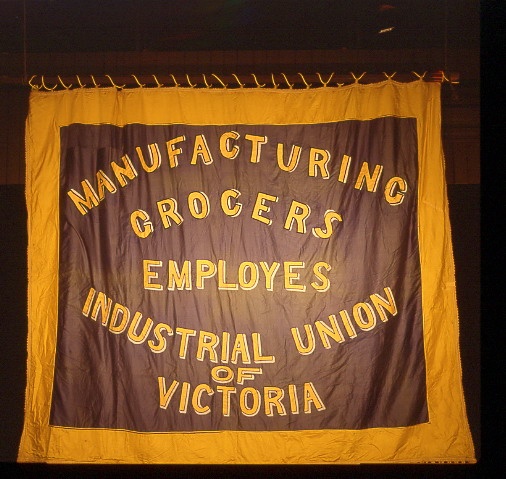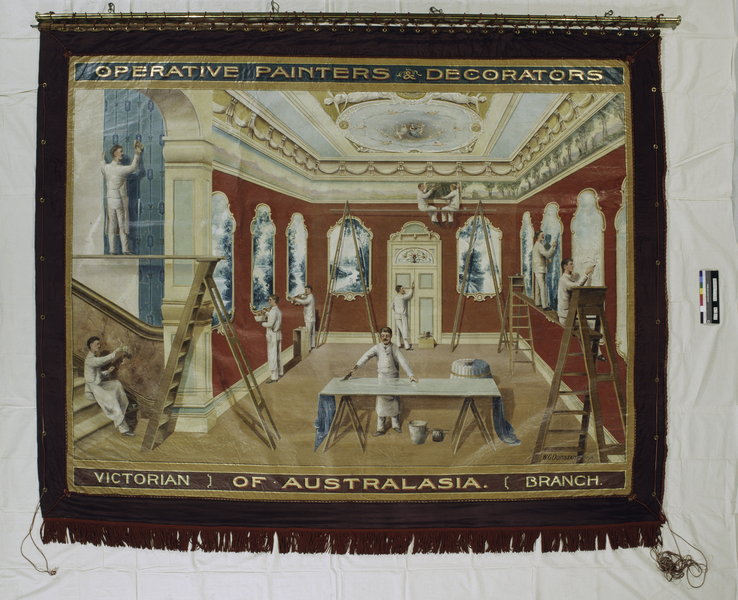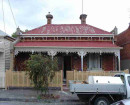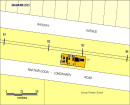EIGHT HOUR DAY TRADE UNION BANNERS
MUSEUM OF VICTORIA, 11 NICHOLSON STREET CARLTON, MELBOURNE CITY
-
Add to tour
You must log in to do that.
-
Share
-
Shortlist place
You must log in to do that.
- Download report









Statement of Significance
What is significant?
Museum Victoria holds the largest collection of Victorian trade union banners used in Eight Hour Day processions from the late 19th century to the First World War. The collection comprises the following eight banners: Amalgamated Society of Engineers, Blacksmiths, Fitters, Patternmakers, Turners & Machinists, Ballarat Branch (artists Kift & Smith, 1890), now the Australian Manufacturing Workers Union; United Ironworkers Assistants Society of Australia, Ballarat Branch (Kift & Smith, 1890), now the AMWU; Australian Railways Union, Victorian Branch (John Hennessy, c.1912), now the Rail, Tram & Bus Union; Manufacturing Grocers Employees Industrial Union of Victoria (c.1910-12), now National Union of Workers; Amalgamated Society of Carpenters & Joiners, Victorian Branch (W. Dunstan, 1914), now the Construction, Forestry, Mining and Energy Union; Operative Painters & Decorators of Australia, Victorian Branch (W. Dunstan, 1915), now the CFMEU; Australian Tramway Employees Association, Victorian Branch (George Grant, 1916), now the Rail, Tram & Bus Union; and Australian Boot Trade Employees Federation, Ballarat Branch (nd), now the Textile Clothing & Footwear Union of Australia.
The first Eight Hour Day procession held in Melbourne in May 1856 celebrated the winning of the eight hour working day by building workers, some of the first workers in the world to achieve these conditions. They marched behind a banner declaring "Eight Hours Labour, Eight Hours Rest, Eight Hours Recreation". Although the right to an eight hour day did not immediately apply to all workers, the movement provided the impetus for other trade unions to agitate for similar conditions. Subsequently the march to celebrate the Eight Hour Day became Melbourne's biggest annual procession and regional towns also staged an annual procession. It grew in popularity after the day was declared a public holiday in 1879, reaching its peak prior to the First World War. In 1903 the Eight Hour Day monument (VHR H2084) was erected in Spring Street and in 1923 was moved to its current location at the corner of Victoria and Russell Streets. In 1934 the public holiday was re-named Labour Day. The procession eventually declined in popularity and ceased in the early 1950s. After 1955 Labour Day became associated with the Moomba procession.
The major features of the processions were the large trade union banners, mounted and carried behind horse-drawn carriages or on floats. Most banners were approximately three metres by four metres and featured paintings on canvas and silk by skilled artists. Banners were commissioned by particular unions to represent the collective identity of a trade and they became important declarations of legitimacy. One side of the banner was usually a realistic depiction of the particular trade, including materials, tools and skills needed to carry it out, while the other side used allegorical figures, females in particular, and symbols brimming with classical allusions, medieval guild references, and heraldic symbols to represent the history and ideals of the trade. Australian references also appeared including the Eight Hour Day symbol of the entwined figure of eight, indigenous flora and fauna and the coats of arms of Australian colonies.
How is it significant?
The Eight Hour Day Trade Union Banners are of historical, social and aesthetic significance to the State of Victoria.
Why is it significant?
The Eight Hour Day Trade Union Banners are of historical and social significance for their important associations with the history of trade unionism in Victoria. The banners are important historical documents visually depicting the concerns of workers, the nature of their work, and the social and cultural aspirations and identity of trade unions. Some of the banners demonstrate the evolving nature of industry in their representation of trades that have disappeared and craft unions that have been subsumed within bigger unions. For trade unionists and many others in the community, the banners are powerful symbols of the role played by unions in advancing conditions and wages of working people.
The banners have historical significance for their association with the Eight Hour Day movement. The symbol of the Eight Hour Day movement, the entwined figure of eight, appears on many of the banners. The granting of the Eight Hour Day was one of the most important industrial reforms won by unionists in the 19th century, contributing towards the image of Australia as the "working man's paradise" in the late 19th century and the development of organised labour.
The banners have historical significance as rare surviving examples of 19th and early 20th century trade union banners. Although hundreds of banners were produced for use in Eight Hour Day (later Labour Day) processions, relatively few are known to survive and this collection represents the only substantial collection in Victoria and one of only two major Eight Hour Day banner collections in Australia.
The banners have aesthetic significance as fine examples of 19th and early 20th century banners demonstrating fine craftsmanship and artistic skills. The highly decorated banners, with their complex mix of symbolism and realistic depictions of contemporary industry, are unique artistic records of the trades, skills and aspirations of working people.
-
-
EIGHT HOUR DAY TRADE UNION BANNERS - Permit Exemptions
General Exemptions:General exemptions apply to all places and objects included in the Victorian Heritage Register (VHR). General exemptions have been designed to allow everyday activities, maintenance and changes to your property, which don’t harm its cultural heritage significance, to proceed without the need to obtain approvals under the Heritage Act 2017.Places of worship: In some circumstances, you can alter a place of worship to accommodate religious practices without a permit, but you must notify the Executive Director of Heritage Victoria before you start the works or activities at least 20 business days before the works or activities are to commence.Subdivision/consolidation: Permit exemptions exist for some subdivisions and consolidations. If the subdivision or consolidation is in accordance with a planning permit granted under Part 4 of the Planning and Environment Act 1987 and the application for the planning permit was referred to the Executive Director of Heritage Victoria as a determining referral authority, a permit is not required.Specific exemptions may also apply to your registered place or object. If applicable, these are listed below. Specific exemptions are tailored to the conservation and management needs of an individual registered place or object and set out works and activities that are exempt from the requirements of a permit. Specific exemptions prevail if they conflict with general exemptions. Find out more about heritage permit exemptions here.Specific Exemptions:General Conditions: 1. All exempted alterations are to be planned and carried out in a manner which prevents damage to the fabric of the registered place or object. General Conditions: 2. Should it become apparent during further inspection or the carrying out of works that original or previously hidden or inaccessible details of the place or object are revealed which relate to the significance of the place or object, then the exemption covering such works shall cease and the Executive Director shall be notified as soon as possible. General Conditions: 3. If there is a conservation policy and plan approved by the Executive Director, all works shall be in accordance with it. General Conditions: 4. Nothing in this determination prevents the Executive Director from amending or rescinding all or any of the permit exemptions.
STANDARD EXEMPTION: MOVEMENT OR RELOCATION
The temporary relocation, movement or external loan of registered heritage objects does not require permit approval by the Executive Director pursuant to the Heritage Act 1995 where the activity is performed in accordance with the accepted standards, policies and procedures of Museum Victoria.
STANDARD EXEMPTION: CONSERVATION
The conservation, research or analysis of registered heritage objects does not require approval by the Executive Director pursuant to the Heritage Act 1995, where the activity is performed in accordance with the accepted standards, policies and procedures of the Museum Victoria.
EIGHT HOUR DAY TRADE UNION BANNERS - Permit Exemption Policy
The objects should be housed and conserved so as to maintain their cultural heritage significance. Exemptions will usually be granted for movement, relocation, loan and conservation activities, as specified below.
-
-
-
-
-
FORMER CARLTON AND UNITED BREWERY
 Victorian Heritage Register H0024
Victorian Heritage Register H0024 -
ROSAVILLE
 Victorian Heritage Register H0408
Victorian Heritage Register H0408 -
MEDLEY HALL
 Victorian Heritage Register H0409
Victorian Heritage Register H0409
-
"1890"
 Yarra City
Yarra City -
'BRAESIDE'
 Boroondara City
Boroondara City -
'ELAINE'
 Boroondara City
Boroondara City
-
-












